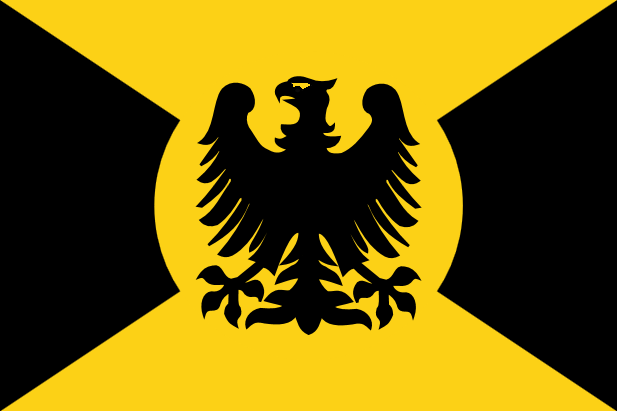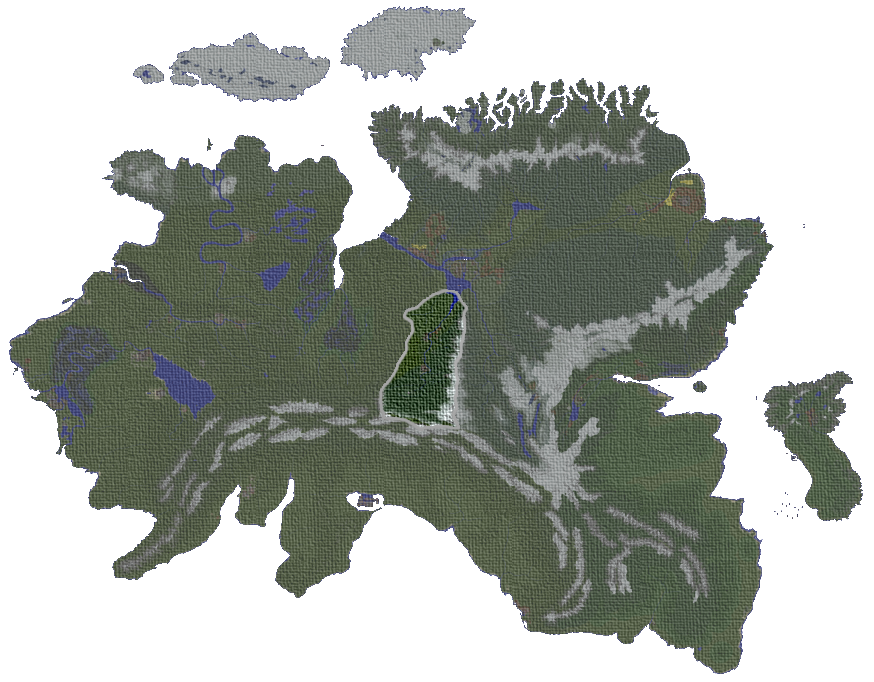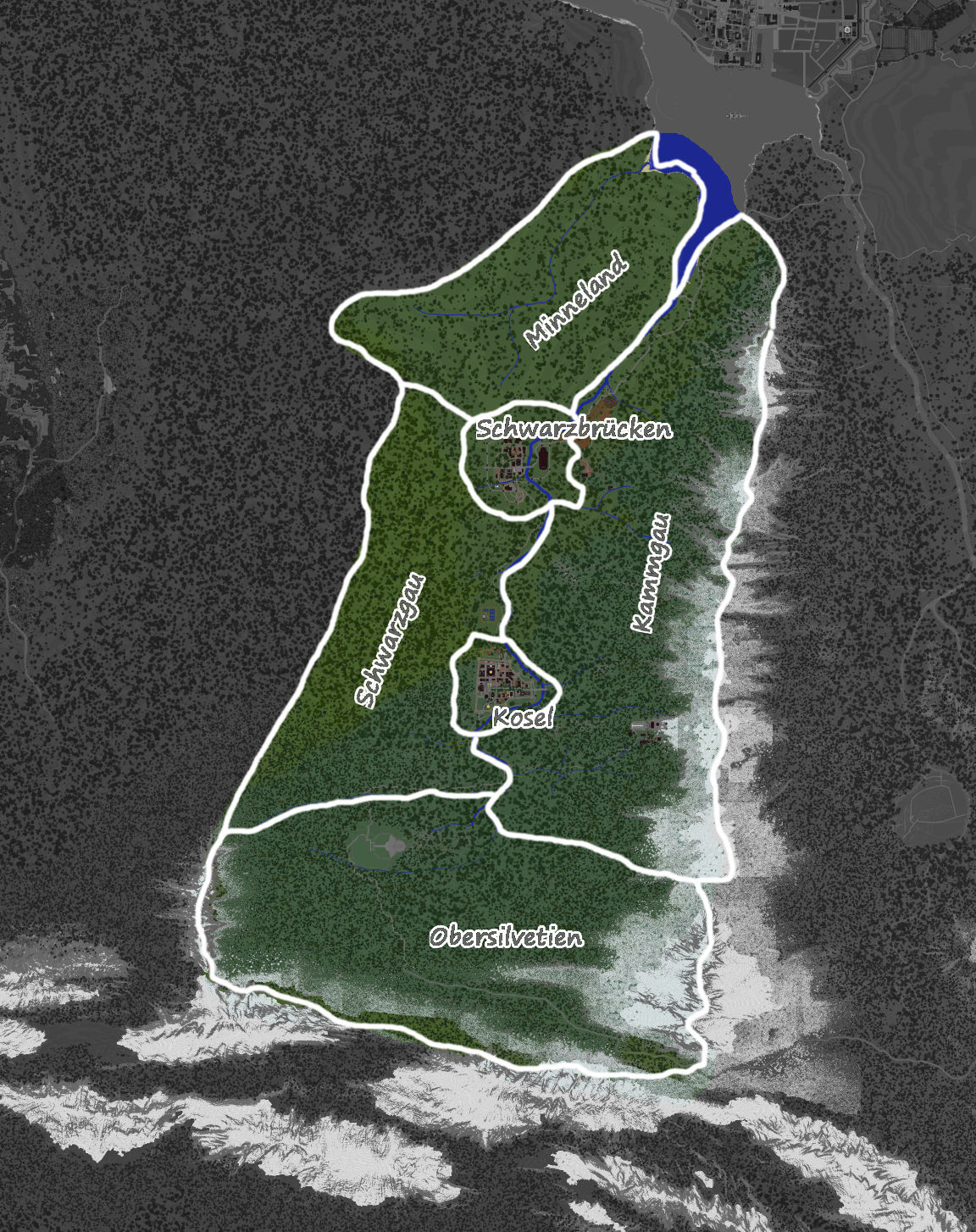Silvetia: Difference between revisions
No edit summary |
No edit summary |
||
| Line 3: | Line 3: | ||
|picofflag = Silvetia_Flag.png | |picofflag = Silvetia_Flag.png | ||
|motto = -- | |motto = -- | ||
|capital = | |capital = [[Kosel]] | ||
|language = | |language = | ||
|language2 = | |language2 = | ||
Latest revision as of 14:57, 1 November 2017
Republic of Silvetia Motto: -- | |
| Capital: | Kosel |
| Religion: Other Religions: |
Sotiran Cult of the Solar Twins |
| Demonym: | Silvetan |
| Ethnic Groups: | Silvetan Lonian |
| Currency: | |

The Republic of Silvetia is a federation of city-states along the Schwarzwasser river south of the Lonian League.
Administrative Division

Silvetia consists of four geographic regions and two major cities. From north to south these are:
- Minneland
- The flat land between the rivers Minne/Mina and Schwarzwasser/Silveta in northwestern Silvetia
- Schwarzgau
- The land west of the river Schwarzwasser
- Kammgau
- The mountainous eastern part of Silvetia, which is dominated by the Dämonenkamm/Silvetus Mons mountain range, separating it from Southern Lonia
- Schwarzbrücken
- The city of Schwarzbrücken and its immediate surroundings
- Kosel
- The city of Kosel, capital of Silvetia, and its immediate surroundings
- Obersilvetien
- The mountainous and heavily forested southern part of Silvetia, cradled by three mountain ranges
Government
Executive body
The executive power is the Council of Seven, also called the Septa. Each Septimius is elected by the Senate for the duration of one year and rules over a ministry of the state:
- The ministry of trade and finances
- The ministry of defense and security
- The ministry of agriculture
- The ministry of industry
- The ministry of culture and religion
- The ministry of state affairs
- The ministry of justice
All decisions of importance to the state as a whole are prepared by the respective ministry but taken by majority vote of the Septa.
Legislative body
The legislative power is concentrated in the Silvetian Parliament, called Senate. It consists of exactly 60 senators who are elected or appointed by the six regions and cities of Silvetia depending on the local customs or laws there. Each of the regions holds ten seats in the Senate who are elected or appointed for a duration of three years in such a way that each year two regions hold elections. The Senate drafts and approves laws and elects the Septa. It cannot interfere with decisions of the Septa, unless a law is conflicted by those. Disputes between the Senate and the Septa are resolved by the High Court.
Juristicadive body
The High Court is the highest legal authority in Silvetia. Its sole purpose in theory is the resolution of disputes between the Senate and the Septa. In practise, though, the main task of the High Court is to handle all jurisdical disputes which have been escalated from the ordinary courts, which are administrated by the ministry of justice.
History
Some of the Silvetian counties are already mentioned in Archadian chronicles of the 7th century AIC. Omnican missionaries brought not only their faith, but also the Archadian alphabet to Silvetia. In the late 8th century AIC, Sotiranity spread to Silvetia and was readily accepted in the towns and most of the upper society. The Omnican clergy used the rural population's conservatism to resist the "heresy", thus starting the Silvetian Religious War of 801-805. With the country devastated and most of the ruling classes eliminated or weakened, Micha I established himself as a Duke of Silvetia to rule over all the counties. Seeking protection against outside threats because of its shattered economy and weakened military, the young Duchy joined the Lonian League and became a de facto vassal thereof. Officially, the Lonian League as a merchant republic could not have vassals though, having made Silvetia de jure an independent duchy. The ensuing grey area was liberally exploited by all parties in order to secure the best possible deals in foreign relations, trade treaties and political power struggles of the various factions. As a duchy, the Duke of Silvetia was the sole ruler in all matters except for foreign relations, which were semi-officially handled by the Lonian League. However, the Duchy was made up of a number of powerful counties, which was why the Duke regularly summoned the nobility to a Landtag (state diet) in order to discuss vital decisions and general strategic directions. Apart from the nobility, the economic power of the burghers of the larger cities rose steadily. Both Schwarzbrücken and Kosel had a city council at the head of the day-to-day politics. Representing almost half of the annual income of the entire duchy, these councils were almost always invited as guests to the state diets, even though they had no official vote there. Official currency is the Lonian Guilder. The only sea port accessible to the local merchants is Rungholt, and all ships going there have to pass through Lake Lone which is guarded by the Lonian capital. However, being a member of the Lonian League, Silvetan merchants do not have to pay the usual tolls and taxes, which is a major boon to the Silvetan trade businesses.
When Duke Micha III (The Mad) tried to curb the power of the burghers with a series of arbitrary court edicts in 1115 AIC, the burghers demanded a state diet to be held. Instead of simply refusing this demand, the Duke ordered all of the leaders of the burgher faction executed, which quickly escalated into a civil war. With the involvement of the Lonian League on behalf of the Duke, the civil war became a war of independence and political change, known as the Silvetian Revolution. While the Republican movement had won militarily by 1116 AIC, the peace treaty was only signed in 1119 AIC.
Religion and Culture
When the Sotiran faith spread rapidly throughout the continent, the Silvetan counties had been devastated in the civil war and could not afford to lose any more of their manpower base. While the Sotiran Church had been declared official state religion, religious freedom was guaranteed for rulers, citizens and visitors. This ended the civil war in Silvetia and attracted a number of religious refugees from neighbouring realms. Today, religious festivities from both major faiths as well as a few foreign practices are widely celebrated and provide plenty of opportunity for drinking, feasting and dancing.
On work days, the Silvetan citizens take pride in their proverbial industriousness though. There is a deep-rooted desire in the heart of Silvetan artisans, artists, jousters, cooks, miners and basically everybody else to outdo the neighbours of the much larger and richer Lonian League. Regular trade fairs are held to display Silvetian goods and art, usually in comparison to Lonian ones.
With the Silvetian Revolution, nationalism has spawned a whole new branch of Silvetian art. Examples are the Eagle and Sun poem and the Silvetian Eagle monument.
Geography
The Republic of Silvetia claims the relatively flat, densely forested land south of Lake Lone, west of the Silvetian Mountains (Archadian: Silvam Montes, also known as Dämonenkamm, meaning Demon's Ridge) and north of the Great Central Mountain Range. The main defining features of said territory are the mountain ranges and the river Schwarzwasser (Archadian: Silveta), the latter being the main means of transportation and thus trade of the country.
Economy
Main exports of the Republic include raw metals, metalware, weaponry, armor, timber, beer and juwelry. Main imports are spices, grain, wine, fruit, cloth and pottery.